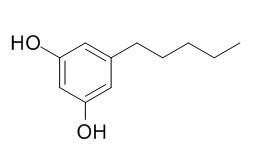Olivetol
Olivetol is a precursor in various syntheses of tetrahydrocannabinol. It acts as a competitive inhibitor of the cannabinoid receptors CB1 and CB2. Olivetol has antioxidant effects.
Inquire / Order:
manager@chemfaces.com
Technical Inquiries:
service@chemfaces.com
Tel:
+86-27-84237783
Fax:
+86-27-84254680
Address:
1 Building, No. 83, CheCheng Rd., Wuhan Economic and Technological Development Zone, Wuhan, Hubei 430056, PRC
Providing storage is as stated on the product vial and the vial is kept tightly sealed, the product can be stored for up to
24 months(2-8C).
Wherever possible, you should prepare and use solutions on the same day. However, if you need to make up stock solutions in advance, we recommend that you store the solution as aliquots in tightly sealed vials at -20C. Generally, these will be useable for up to two weeks. Before use, and prior to opening the vial we recommend that you allow your product to equilibrate to room temperature for at least 1 hour.
Need more advice on solubility, usage and handling? Please email to: service@chemfaces.com
The packaging of the product may have turned upside down during transportation, resulting in the natural compounds adhering to the neck or cap of the vial. take the vial out of its packaging and gently shake to let the compounds fall to the bottom of the vial. for liquid products, centrifuge at 200-500 RPM to gather the liquid at the bottom of the vial. try to avoid loss or contamination during handling.
Biochem Pharmacol.2017, 130:10-20
Korean J Dent Mater.2018, 45(2):139-146
Evid Based Complement Alternat Med.2017, 2017:1401279
Chem Biol Interact.2024, 394:110995.
Molecules.2020, 25(20):4851.
Front Aging Neurosci.2019, 11:230
Naunyn Schmiedebergs Arch Pharmacol.2017, 390(10):1073-1083
Int J Mol Sci.202, 25(17):9246.
Cardiovasc Toxicol.2019, 19(4):297-305
Acta Pharmaceutica Hungarica2016, 86:35-40
Related and Featured Products
Se Pu. 2013 Jun;31(6):587-95.
Preparation and evaluation of molecularly imprinted polymer of olivetol for solid phase extraction.[Pubmed:
24063201]
Molecularly imprinted polymer (MIP) was synthesized by bulk polymerization, using Olivetol as template molecule, methyl acrylic acid (MAA) as monomer, ethylene glycol dimethacrylate (EDMA) as crosslinker, toluene and dodecanol as solvents.
METHODS AND RESULTS:
The resulted MIP was characterized by the equilibrium binding experiments, scanning electron microscope (SEM) and Fourier transform infrared spectrometer (FTIR). The polymer was then applied to solid phase extraction (SPE) of Olivetol from spiked wheat bran samples. From the equilibrium binding experiments, it was showed that MIP had a better recognizability for the template molecule. Scatchard analysis showed that MIP had specific adsorption to Olivetol with two classes of binding sites. The high and low binding sites dissociation constants were 0.021 and 1.002 mmol/L. The corresponding maximum binding capacities were 18.74 and 135.9 micromol/g, respectively. Under the optimum condition of SPE, the recoveries of Olivetol on MIP cartridge were in the range of 97.8% - 98.8%. The relative standard deviations (RSDs) were 2.8% -4.2%. The linearity range was between 0.1 and 100 mg/L. The limit of detection (S/N = 3) was 0.062 mg/L.
CONCLUSIONS:
MIP cartridge showed stronger selectivity, higher recovery and purified the sample more drastically compared with non-imprinted polymer (NIP) cartridge and commercial poly (styrene/divinyl-benzene) (PLS) cartridge.
Free Radic Res. 1998 Apr;28(4):359-68.
Quantum mechanical and experimental oxidation studies of pentadecylresorcinol, olivetol, orcinol and resorcinol.[Pubmed:
9684980]
Resorcinols (pentadecylresorcinol, Olivetol, orcinol and resorcinol) exhibit antioxidant properties in liposomal systems. Antioxidant potency depends on the length of the alkyl chain.
J Nat Prod. 1984 Sep-Oct;47(5):828-34.
Biotransformation of olivetol by Syncephalastrum racemosum.[Pubmed:
6512535]
METHODS AND RESULTS:
A study of the biotransformation of Olivetol by Syncephalastrum racemosum ATCC 18192 has led to the isolation of three metabolites, which were identified as 4'-hydroxy-Olivetol, 3-(3,5-dihydroxyphenyl)-1-propanol, and 3-(3,5-dihydroxyphenyl)-1-propanoic acid. The structures of the isolated metabolites were deduced by comparison of their spectral properties (pmr, cmr, ms) with those of Olivetol. The absolute configuration of 4'-hydroxy-Olivetol was determined to be R by the Horeau partial resolution method.
CONCLUSIONS:
Biotransformation of Olivetol therefore appears to occur by a subterminal oxidation process.



